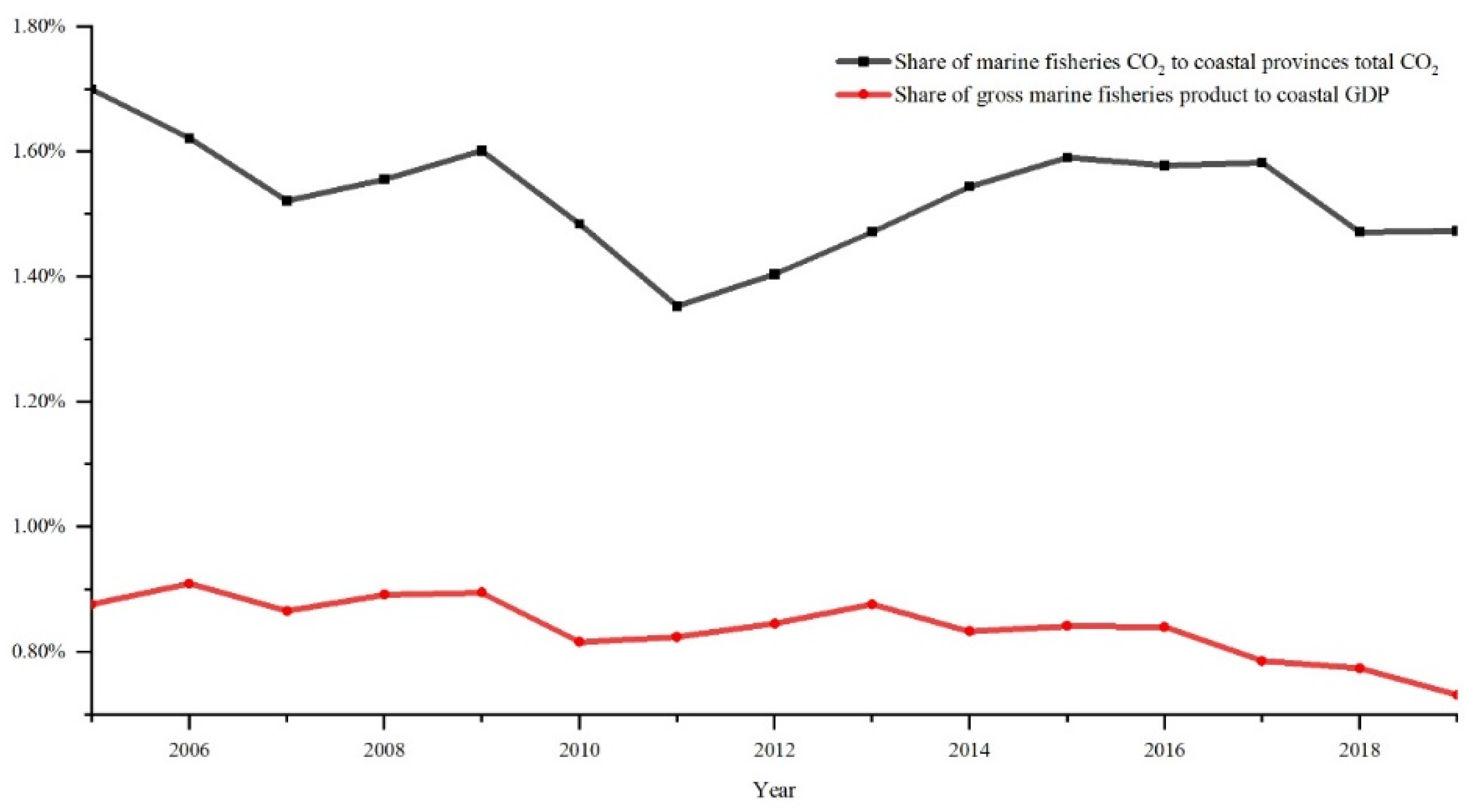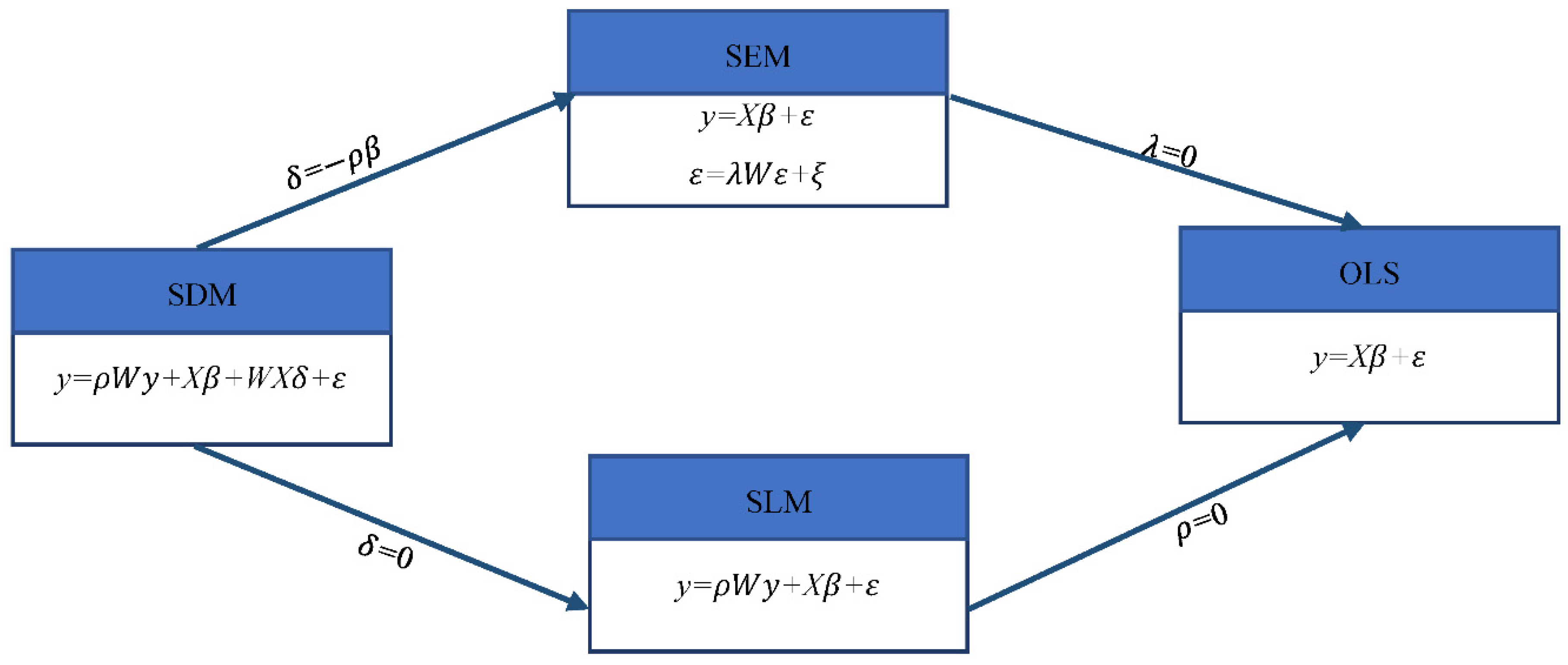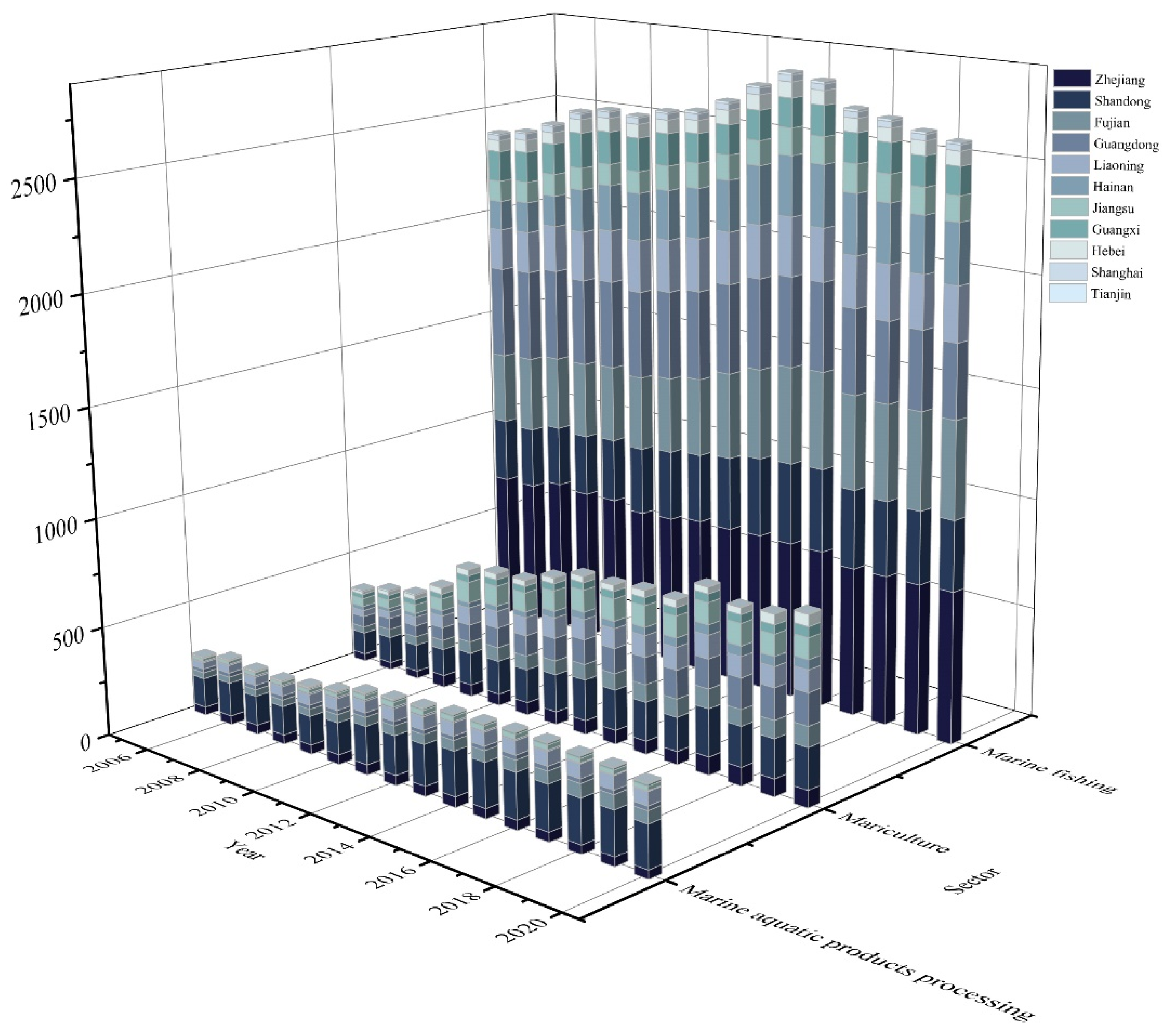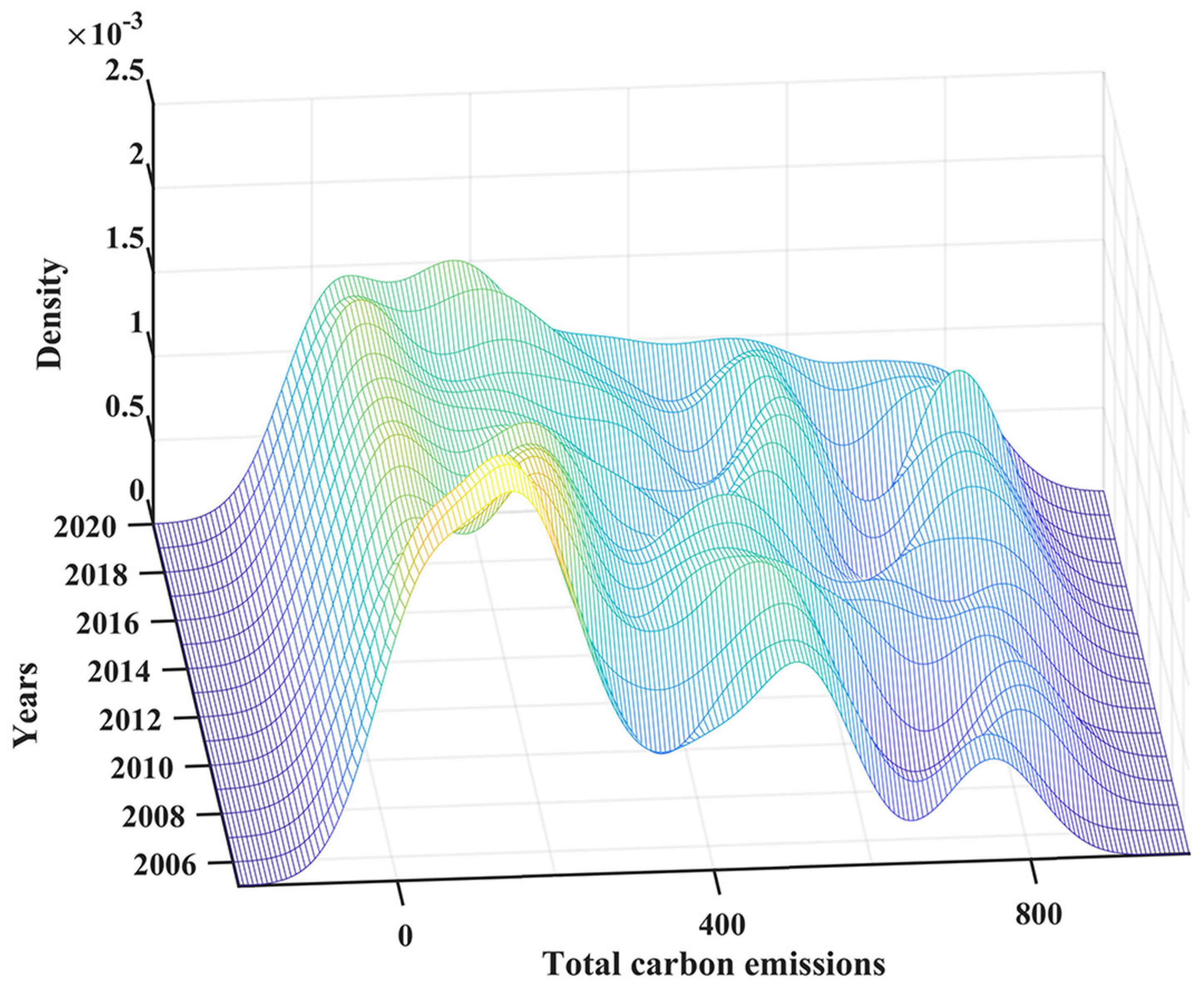Driving Factors and Spatiotemporal Characteristics of CO2 Emissions from Marine Fisheries in China: A Commonly Neglected Carbon-Intensive Sector
Abstract
:1. Introduction
2. Literature Review
3. Methodology and Data
3.1. Calculation Framework and Data
- CO2 emissions from the marine fishing sector mainly come from the consumption of diesel fuel by capture fishing vessels;
- CO2 emissions from the mariculture sector come from two sources: first, the consumption of diesel fuel by mariculture fishing vessels, and second, the consumption of electricity by oxygen supply and electric pumps in mariculture ponds and industrial farming;
- CO2 emissions from the marine aquatic product processing sector mainly come from the electricity consumed by cold storage and processing. The formula is as follows:
3.2. Variable Description
3.3. Model Settings
3.3.1. Kernel Density Estimation
3.3.2. Spatial Econometric Model
4. Results and Discussion
4.1. Spatial and Temporal Characteristics of CO2 Emissions from Marine Fisheries
4.1.1. CO2 Levels and Time-Varying Characteristics
4.1.2. Spatial Variability Characteristics
4.2. Test Results
4.2.1. Autocorrelation Test Results
4.2.2. The LM, LR, and WALD Tests
4.3. Estimation Results
4.3.1. Spatial Measurement Results
4.3.2. Robustness Tests
4.3.3. Spatial Spillover Effect Analysis
5. Conclusions
6. Policy Implications and Future Research
Author Contributions
Funding
Institutional Review Board Statement
Informed Consent Statement
Data Availability Statement
Conflicts of Interest
References
- IPCC. Summary for Policymakers of IPCC Special Report on Global Warming of 1.5 °C Approved by Governments; IPCC: Incheon, Republic of Korea, 2018.
- Pena, V. In the Stern Review and the Uncertainties in the Economics of Climate Change; Springer: Berlin/Heidelberg, Germany, 2007; pp. 351–382. [Google Scholar]
- Gattuso, J.P.; Magnan, A.; Bille, R.; Cheung, W.W.L.; Howes, E.L.; Joos, F.; Allemand, D.; Bopp, L.; Cooley, S.R.; Eakin, C.M.; et al. Contrasting futures for ocean and society from different anthropogenic CO2 emissions scenarios. Science 2015, 349, 46–57. [Google Scholar] [CrossRef] [PubMed]
- Allison, E.H.; Bassett, H.R. Climate change in the oceans: Human impacts and responses. Science 2015, 350, 778–782. [Google Scholar] [CrossRef] [PubMed]
- Doney, S.C.; Fabry, V.J.; Feely, R.A.; Kleypas, J.A. Ocean Acidification: The Other CO2 Problem. Annu. Rev. Mar. Sci. 2009, 1, 169–192. [Google Scholar] [CrossRef] [PubMed] [Green Version]
- Orr, J.C.; Fabry, V.J.; Aumont, O.; Bopp, L.; Doney, S.C.; Feely, R.A.; Gnanadesikan, A.; Gruber, N.; Ishida, A.; Joos, F.; et al. Anthropogenic ocean acidification over the twenty-first century and its impact on calcifying organisms. Nature 2005, 437, 681–686. [Google Scholar] [CrossRef] [Green Version]
- Cacciapaglia, C.W.; Woesik, V.R. Reduced carbon emissions and fishing pressure are both necessary for equatorial coral reefs to keep up with rising seas. Ecography 2020, 43, 789–800. [Google Scholar] [CrossRef] [Green Version]
- Moore, J.K.; Fu, W.W.; Primeau, F.; Britten, G.L.; Lindsay, K.; Long, M.; Doney, S.C.; Mahowald, N.; Hoffman, F.; Randerson, J.T. Sustained climate warming drives declining marine biological productivity. Science 2018, 359, 1139–1142. [Google Scholar] [CrossRef] [Green Version]
- Poloczanska, E.S.; Burrows, M.T.; Brown, C.J.; Molinos, J.G.; Halpern, B.S.; Hoegh-Guldberg, O.; Kappel, C.V.; Moore, P.J.; Richardson, A.J.; Schoeman, D.S.; et al. Responses of Marine Organisms to Climate Change across Oceans. Front. Mar. Sci. 2016, 3, 21. [Google Scholar] [CrossRef] [Green Version]
- Allison, L.P. Climate change and distribution shifts in marine fishes. Science 2005, 308, 1912. [Google Scholar]
- Kroeker, K.J.; Kordas, R.L.; Crim, R.N.; Singh, G.G. Meta-analysis reveals negative yet variable effects of ocean acidification on marine organisms. Ecol. Lett. 2010, 13, 1419–1434. [Google Scholar] [CrossRef]
- Schmidtko, S.; Stramma, L.; Visbeck, M. Decline in global oceanic oxygen content during the past five decades. Nature 2017, 542, 335–339. [Google Scholar] [CrossRef]
- Dubik, B.A.; Clark, E.C.; Young, T.; Zigler, S.B.J.; Provost, M.M.; Pinsky, M.L.; St Martin, K. Governing fisheries in the face of change: Social responses to long-term geographic shifts in a US fishery. Mar. Pol. 2019, 99, 243–251. [Google Scholar] [CrossRef]
- Pecl, G.T.; Araujo, M.B.; Bell, J.D.; Blanchard, J.; Bonebrake, T.C.; Chen, I.C.; Clark, T.D.; Colwell, R.K.; Danielsen, F.; Evengard, B.; et al. Biodiversity redistribution under climate change: Impacts on ecosystems and human well-being. Science 2017, 355, 9. [Google Scholar] [CrossRef] [PubMed]
- Cheung, W.W.L.; Frolicher, T.L.; Asch, R.G.; Jones, M.C.; Pinsky, M.L.; Reygondeau, G.; Rodgers, K.B.; Rykaczewski, R.R.; Sarmiento, J.L.; Stock, C.; et al. Building confidence in projections of the responses of living marine resources to climate change. ICES J. Mar. Sci. 2016, 73, 1283–1296. [Google Scholar] [CrossRef] [Green Version]
- Blasiak, R.; Yagi, N.; Kurokura, H. Impacts of hegemony and shifts in dominance on marine capture fisheries. Mar. Pol. 2015, 52, 52–58. [Google Scholar] [CrossRef]
- Cheung, W.W.L.; Lam, V.W.Y.; Sarmiento, J.L.; Kearney, K.; Watson, R.; Zeller, D.; Pauly, D. Large-scale redistribution of maximum fisheries catch potential in the global ocean under climate change. Glob. Chang. Biol. 2010, 16, 24–35. [Google Scholar] [CrossRef]
- de Suarez, J.M.; Cicin-Sain, B.; Wowk, K.; Payet, R.; Hoegh-Guldberg, O. Ensuring survival: Oceans, climate and security. Ocean Coast. Manag. 2014, 90, 27–37. [Google Scholar] [CrossRef]
- Pauly, D.; Zeller, D. Comments on FAOs State of World Fisheries and Aquaculture. Mar. Pol. 2017, 77, 176–181. [Google Scholar] [CrossRef]
- Cui, L.B.; Li, R.J.; Song, M.L.; Zhu, L. Can China achieve its 2030 energy development targets by fulfilling carbon intensity reduction commitments? Energy Econ. 2019, 83, 61–73. [Google Scholar] [CrossRef]
- Wang, K.L.; Zhao, B.; Fan, T.Z.; Zhang, J.N. Economic Growth Targets and Carbon Emissions: Evidence from China. Int. J. Environ. Res. Public Health 2022, 19, 8053. [Google Scholar] [CrossRef]
- Mariani, G.; Cheung, W.W.L.; Lyet, A.; Sala, E.; Mayorga, J.; Velez, L.; Gaines, S.D.; Dejean, T.; Troussellier, M.; Mouillot, D. Let more big fish sink: Fisheries prevent blue carbon sequestration-half in unprofitable areas. Sci. Adv. 2020, 6, 8. [Google Scholar] [CrossRef]
- Ferrer, E.M.; Aburto-Oropeza, O.; Jimenez-Esquivel, V.; Cota-Nieto, J.J.; Mascarenas-Osorio, I.; Lopez-Sagastegui, C. Mexican Small-Scale Fisheries Reveal New Insights into Low-Carbon Seafood and “Climate-Friendly” Fisheries Management. Fish. A Bull. Am. Fish. Soc. 2021, 46, 277–287. [Google Scholar] [CrossRef]
- Parker, R. Energy Performance of Wild-Capture Marine Fisheries at Global, Regional, and Local Scales; University of Tasmania: Tasmania, Australia, 2016. [Google Scholar]
- Parker, R.W.R.; Blanchard, J.L.; Gardner, C.; Green, B.S.; Hartmann, K.; Tyedmers, P.H.; Watson, R.A. Fuel use and greenhouse gas emissions of world fisheries. Nat. Clim. Chang. 2018, 8, 333–337. [Google Scholar] [CrossRef]
- Greer, K.; Zeller, D.; Woroniak, J.; Coulter, A.; Winchester, M.; Palomares, M.L.D.; Pauly, D. Global trends in carbon dioxide (CO2) emissions from fuel combustion in marine fisheries from 1950 to 2016. Mar. Pol. 2019, 107, 9. [Google Scholar] [CrossRef]
- Parker, R.W.R.; Tyedmers, P.H. Fuel consumption of global fishing fleets: Current understanding and knowledge gaps. Fish. Fish. 2015, 16, 684–696. [Google Scholar] [CrossRef]
- Blasiak, R.; Spijkers, J.; Tokunaga, K. Climate change and marine fisheries: Least developed countries top global index of vulnerability. PLoS ONE 2017, 12, 1–15. [Google Scholar] [CrossRef] [Green Version]
- Zhang, Z.W.W.; He, Y. The calculation of emissions of carbon during the process of fishing boats operations in China. J. Shanghai Ocean. Univ. 2010, 19, 848–862. [Google Scholar]
- Qing, W.Y. Applicafion of IPCC Emission Factor Method in the Assessment of Fishery Carbon Emissions Reduction. Mod. Agric. Sci. Technol. 2015, 20, 165–182. [Google Scholar]
- Wu, J.H.; Li, B. Spatio-temporal evolutionary characteristics of carbon emissions and carbon sinks of marine industry in China and their time-dependent models. Mar. Pol. 2022, 135, 104879. [Google Scholar] [CrossRef]
- Feng, C.C.; Ye, G.Q.; Jiang, Q.T.; Zheng, Y.H.; Chen, G.W.; Wu, J.P.; Feng, X.H.; Si, Y.L.; Zeng, J.N.; Li, P.L.; et al. The contribution of ocean-based solutions to carbon reduction in China. Sci. Total Environ. 2021, 797, 149168. [Google Scholar] [CrossRef]
- Tyedmers, P. Fisheries and Energy Use: Encyclopedia of Energy; Elsevier Science: Amsterdam, The Netherlands, 2004; pp. 683–693. [Google Scholar]
- Devi, M.S.; Xavier, K.A.M.; Singh, A.S.; Edwin, L.; Singh, V.V.; Shenoy, L. Environmental pressure of active fishing method: A study on carbon emission by trawlers from north-west Indian coast. Mar. Pol. 2021, 127, 104453. [Google Scholar] [CrossRef]
- Van, T.C.; Ramirez, J.; Rainey, T.; Ristovski, Z.; Brown, R.J. Global impacts of recent IMO regulations on marine fuel oil refining processes and ship emissions. Transp. Res. Part D-Transp. Environ. 2019, 70, 123–134. [Google Scholar] [CrossRef]
- Chassot, E.; Antoine, S.; Guillotreau, P.; Lucas, J.; Assan, C.; Marguerite, M.; Bodin, N. Fuel consumption and air emissions in one of the world’s largest commercial fisheries. Environ. Pollut. 2021, 273, 116454. [Google Scholar] [CrossRef] [PubMed]
- Vazquez-Rowe, I.; Tyedmers, P. Identifying the importance of the “skipper effect” within sources of measured inefficiency in fisheries through data envelopment analysis (DEA). Mar. Pol. 2013, 38, 387–396. [Google Scholar] [CrossRef]
- Sandison, F.; Hillier, J.; Hastings, A.; Macdonald, P.; Mouat, B.; Marshall, C.T. The environmental impacts of pelagic fish caught by Scottish vessels. Fish Res. 2021, 236, 105850. [Google Scholar] [CrossRef]
- Cheilari, A.; Guillen, J.; Damalas, D.; Barbas, T. Effects of the fuel price crisis on the energy efficiency and the economic performance of the European Union fishing fleets. Mar. Pol. 2013, 40, 18–24. [Google Scholar] [CrossRef]
- Sumaila, U.R.; Teh, L.; Watson, R.; Tyedmers, P.; Pauly, D. Fuel price increase, subsidies, overcapacity, and resource sustainability. ICES J. Mar. Sci. 2008, 65, 832–840. [Google Scholar] [CrossRef] [Green Version]
- Salz, P.; Smit, J. The Impact of the Increase of the Oil Price in European Fisheries; European Parliamentary Research Service: Brussels, Belgium, 2006. [Google Scholar]
- Sumaila, U.R.; Palacios-Abrantes, J.; Cheung, W.W.L. Climate change, shifting threat points, and the management of transboundary fish stocks. Ecol. Soc. 2020, 25, 40. [Google Scholar] [CrossRef]
- Schau, E.M.; Ellingsen, H.; Endal, A.; Aanondsen, S.A. Energy consumption in the Norwegian fisheries. J. Clean Prod. 2009, 17, 325–334. [Google Scholar] [CrossRef] [Green Version]
- Sala, A.; Damalas, D.; Labanchi, L.; Martinsohn, J.; Moro, F.; Sabatella, R.; Notti, E. Energy audit and carbon footprint in trawl fisheries. Sci. Data 2022, 9, 20. [Google Scholar] [CrossRef]
- Koričan, M.; Perčić, M.; Vladimir, N.; Alujević, N.; Fan, A. Alternative Power Options for Improvement of the Environmental Friendliness of Fishing Trawlers. J. Mar. Sci. Eng. 2022, 10, 1882. [Google Scholar] [CrossRef]
- Xu, H.; Liu, H.; Zhang, J.; Ni, Q.; Shen, J.; Jiang, L. Estimation of fishery energy consumption in China. China Fish. 2007. [Google Scholar]
- Acar, S.; Soderholm, P.; Brannlund, R. Convergence of per capita carbon dioxide emissions: Implications and meta-analysis. Clim. Policy 2018, 18, 512–525. [Google Scholar] [CrossRef]
- Silverman, B.W. Density Estimation for Statistics and Data Analysis; Chapman and Hall: London, UK, 1986. [Google Scholar]
- Senga Kiesse, T.; Corson, M.S. The utility of less-common statistical methods for analyzing agricultural systems: Focus on kernel density estimation, copula modeling and extreme value theory. Behaviormetrika 2022. [Google Scholar] [CrossRef]
- Tian, Y.; Zhang, J.; Chen, Q. Distributional dynamic and trend evolution of China’s agricultural carbon emissions—An analysis on panel data of 31 provinces from 2002 to 2011. Chin. J. Popul. Resour. Environ. 2015, 13, 206–214. [Google Scholar] [CrossRef]
- Engo, J. Decomposing the decoupling of CO2 emissions from economic growth in Cameroon. Environ. Sci. Pollut. Res. 2018, 25, 35451–35463. [Google Scholar] [CrossRef]
- Anselin, L. Spatial Econometrics: Methods and Models; Springer: Berlin/Heidelberg, Germany, 1988. [Google Scholar]
- Lesage, J.; Pace, R.K. Introduction to Spatial Econometrics; Chapman and Hall/CRC: Boca Raton, FL, USA, 2009. [Google Scholar]
- Lu, T.; Zhu, Z. The Influence of Artificial Intelligence on Labor Income Share from the Perspective of Space: Analysis Based on Static and Dynamic Space Durbin Model. Inq. Into Econ. Issues 2022, 5, 65–78. (In Chinese) [Google Scholar]
- Chen, Q.; Lin, S.; Zhang, X. The Effect of China’s Incentive Policies for Technological Innovation: Incentivizing Quantity or Quality. China Ind. Econ. 2020, 4, 79–96. (In Chinese) [Google Scholar]







| Symbol | Meaning | Symbol | Meaning |
|---|---|---|---|
| Total carbon emissions of marine fisheries | i | Coastal provinces of China | |
| Carbon emissions from marine fishing | t | Study period from 2005 to 2020 | |
| Carbon emissions from mariculture | Net calorific value of diesel fuel | ||
| Carbon emissions from marine aquatic products processing | Conversion factor of diesel fuel to standard coal | ||
| Total energy (diesel) consumed by marine fishing | Coefficient of electric power conversion to CO2 of each province | ||
| Total power of marine fishing vessels | Oxidation rate of diesel combustion | ||
| Total energy (diesel) consumed by mariculture fishing vessels | Carbon content per unit calorific value of diesel fuel | ||
| Electricity consumption during seafood processing | Energy consumption coefficient of marine aquaculture fishing vessel operation | ||
| Electricity consumption during seafood freezing | Energy consumption coefficient of different operation modes of marine fishing vessels | ||
| Power consumption of oxygen supply and electric pump during mariculture ponds and industrial farming. | p | Operation mode of marine fishing vessels: trawling, purse seining, gill netting, spread netting, fishing gear, and others |
| Variable Name | Calculation Process | |
|---|---|---|
| Dependent variable | Carbon emissions per capita of marine fisheries (lnPCO2) | Total carbon emissions from marine fisheries divided by marine fishery population |
| Independent variable | Marine fishery economic development (lnGMFP) | Gross marine fishery product |
| Marine fishery industry structure optimization (lnINDUS) | Marine fishery tertiary industry divided by secondary industry | |
| Marine fishery technology innovation (lnTECH) | Internal expenditure of R&D funds for marine fishery science and technology promotion | |
| Increase in fishermen’s income (lnPCI) | Fishermen’s net income per capita | |
| Deepening of seafood trade (lnIMEX) | Total import and export of marine fishery | |
| Environmental regulation (lnPOL) | Proportion of “ reduced vessels and reduced power” fishing vessels to total fishing vessels |
| Test Method | Statistics | p-Value | |
|---|---|---|---|
| LM test | Spatial error | ||
| Moran’s I | 2.09 | 0.037 | |
| Robust LM | 16.217 | 0.000 | |
| Spatial lag | |||
| Robust LM | 22.666 | 0.000 | |
| LR test | SAR nested within SDM | ||
| LR (6) | 19.92 | 0.0029 | |
| SEM nested within SDM | |||
| LR (6) | 15.99 | 0.0138 | |
| WALD test | SAR (6) | 21.13 | 0.0017 |
| SEM (6) | 16.46 | 0.0115 | |
| lnPCO2 | (1) | (2) | (3) | Robustness Tests | ||
|---|---|---|---|---|---|---|
| (6) Winsorize | ||||||
| lnGMFP | 0.115 ** | −0.123 *** | 0.121 ** | 0.131 ** | 0.0358 | 0.116 ** |
| (0.0528) | (0.0206) | (0.0497) | (0.0548) | (0.0267) | (0.0505) | |
| lnINDUS | 0.138 ** | 0.121 | 0.128 * | 0.124 * | 0.0598 | 0.123 * |
| (0.0657) | (0.104) | (0.0656) | (0.0683) | (0.0787) | (0.0670) | |
| lnPIC | −0.351 *** | 0.289 * | −0.430 *** | −0.463 *** | −0.469 *** | −0.423 *** |
| (0.109) | (0.155) | (0.114) | (0.117) | (0.116) | (0.120) | |
| lnTECH | −0.0335 *** | 0.0514 *** | −0.0261 ** | −0.0246 ** | −0.0418 *** | −0.0250 ** |
| (0.0116) | (0.0140) | (0.0124) | (0.0120) | (0.0130) | (0.0125) | |
| lnPOL | −0.103 | −0.998 *** | −0.0240 | −0.641 * | −0.0244 | −0.0298 |
| (0.328) | (0.361) | (0.330) | (0.332) | (0.329) | (0.336) | |
| lnIMEX | 0.0653 * | 0.0636 ** | 0.108 *** | 0.0612 | 0.0731 ** | 0.103 *** |
| (0.0355) | (0.0319) | (0.0355) | (0.0396) | (0.0347) | (0.0360) | |
| W × lnGMFP | −0.0185 | −0.394 *** | −0.0131 | 0.206 | −0.172 *** | −0.0261 |
| (0.121) | (0.103) | (0.138) | (0.131) | (0.0649) | (0.143) | |
| W × lnINDUS | 0.323 *** | 0.195 | 0.256 * | 0.193 | 0.133 | 0.266 * |
| (0.0979) | (0.199) | (0.147) | (0.166) | (0.194) | (0.149) | |
| W × lnENERGY | 0.533 *** | 2.864 *** | −0.0919 | 0.137 | −0.272 | −0.0227 |
| (0.183) | (0.314) | (0.324) | (0.286) | (0.392) | (0.344) | |
| W × lnTECH | −0.00504 | −0.0246 | −0.00506 | 0.0268 | −0.0193 | −0.00440 |
| (0.0206) | (0.0349) | (0.0343) | (0.0319) | (0.0368) | (0.0347) | |
| W × lnPOL | 0.206 | −2.170 *** | 0.126 | −2.087 *** | 0.834 | 0.123 |
| (0.506) | (0.746) | (0.605) | (0.711) | (0.697) | (0.616) | |
| W × lnimex | 0.129 | −0.301 *** | 0.366 *** | 0.168 * | 0.361 *** | 0.346 *** |
| (0.0925) | (0.111) | (0.100) | (0.0859) | (0.119) | (0.101) | |
| −0.353 *** | −0.00680 | −0.536 *** | −0.516 *** | −0.420 *** | −0.526 *** | |
| (0.109) | (0.106) | (0.107) | (0.104) | (0.133) | (0.107) | |
| Province effect | Yes | No | Yes | Yes | Yes | Yes |
| Year effect | No | Yes | Yes | Yes | Yes | Yes |
| R-squared | 0.209 | 0.302 | 0.539 | 0.2218 | 0.035 | 0.536 |
| lnPCO2 | Direct Effect | Indirect Effect (Spillover Effect) | Total Effect |
|---|---|---|---|
| lnGMFP | 0.000396 ** | −0.000905 ** | −0.000509 |
| (0.000201) | (0.000387) | (0.000391) | |
| lnINDUS | 0.0628 | 0.229 *** | 0.292 *** |
| (0.0692) | (0.0850) | (0.0720) | |
| lnPIC | −0.439 *** | 0.832 *** | 0.393 *** |
| (0.117) | (0.180) | (0.137) | |
| lnTECH | −0.0316 *** | −0.00217 | −0.0338 ** |
| (0.0122) | (0.0185) | (0.0165) | |
| lnPOL | −0.0813 | 0.0841 | 0.00277 |
| (0.367) | (0.472) | (0.485) | |
| lnIMEX | 0.0792 ** | 0.0204 | 0.0996 |
| (0.0396) | (0.0865) | (0.0890) |
Disclaimer/Publisher’s Note: The statements, opinions and data contained in all publications are solely those of the individual author(s) and contributor(s) and not of MDPI and/or the editor(s). MDPI and/or the editor(s) disclaim responsibility for any injury to people or property resulting from any ideas, methods, instructions or products referred to in the content. |
© 2023 by the authors. Licensee MDPI, Basel, Switzerland. This article is an open access article distributed under the terms and conditions of the Creative Commons Attribution (CC BY) license (https://creativecommons.org/licenses/by/4.0/).
Share and Cite
Zhang, X.; Ye, S.; Shen, M. Driving Factors and Spatiotemporal Characteristics of CO2 Emissions from Marine Fisheries in China: A Commonly Neglected Carbon-Intensive Sector. Int. J. Environ. Res. Public Health 2023, 20, 883. https://doi.org/10.3390/ijerph20010883
Zhang X, Ye S, Shen M. Driving Factors and Spatiotemporal Characteristics of CO2 Emissions from Marine Fisheries in China: A Commonly Neglected Carbon-Intensive Sector. International Journal of Environmental Research and Public Health. 2023; 20(1):883. https://doi.org/10.3390/ijerph20010883
Chicago/Turabian StyleZhang, Xiao, Shengchao Ye, and Manhong Shen. 2023. "Driving Factors and Spatiotemporal Characteristics of CO2 Emissions from Marine Fisheries in China: A Commonly Neglected Carbon-Intensive Sector" International Journal of Environmental Research and Public Health 20, no. 1: 883. https://doi.org/10.3390/ijerph20010883
APA StyleZhang, X., Ye, S., & Shen, M. (2023). Driving Factors and Spatiotemporal Characteristics of CO2 Emissions from Marine Fisheries in China: A Commonly Neglected Carbon-Intensive Sector. International Journal of Environmental Research and Public Health, 20(1), 883. https://doi.org/10.3390/ijerph20010883






